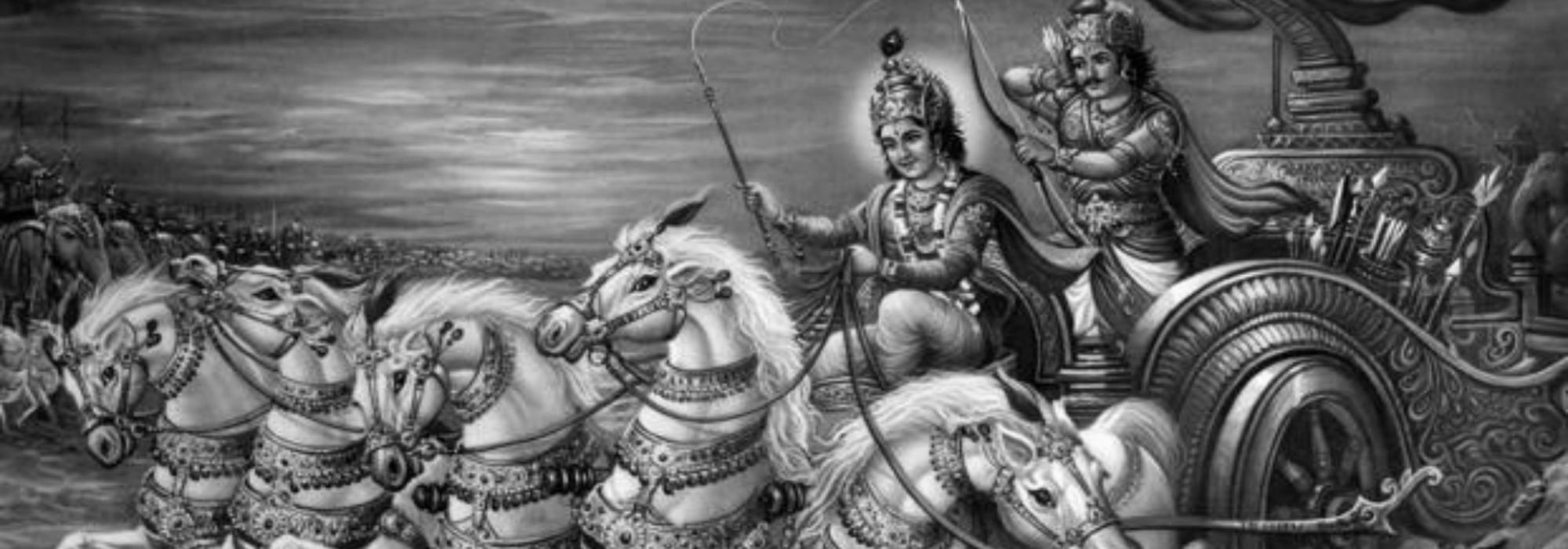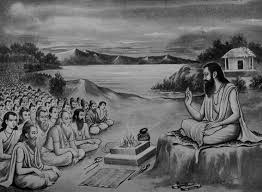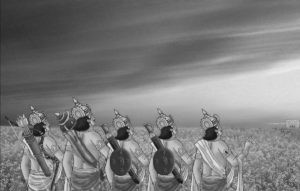Adhyāyas 54-61 : Ādivaṃśāvataraṇa -parva
The ādivaṃśāvataraṇa-(upa-) parva spans eight adhyāyas – from the fifty fourth to the sixty first. In the beginning of this, i.e.., the fifty-fourth chapter, Vyāsa comes to Janamejaya’s sarpa-yāga. Janamejaya pays respects to him and asks “You have seen the Kauravas and Pāṇḍavas with your own eyes; Tell me the story of how they drifted apart, fought a war and lost their lives”. Vyāsa told his disciple Vaiśampāyana who was sitting by him “You have heard from me how the Kauravas and the Pāṇḍavas drifted away form each other – please narrate the story to Janamejaya.” Accordingly, Vaiśampāyana tells King Janamejaya and the other kings assembled there, the ancient story of the breach in the relationship between the Kauravas and the Pāṇḍavas and how they lost their kingdom. Thus ends the adhyāya.
It is in the fifty-fifth adhyāya that we for the first time hear Vaiśampāyana’s words. [From the adhyāya 1, verse 8 until this point, it is the Sūta-Paurāṇika who spoke]
So, Vaiśampāyana recites the following benedictory verses and begins narrating a summarised version of the Bhārata epic.
गुरवे प्राङ्नमस्कृत्य
मनोबुद्धिसमादिभिः ।
सम्पूज्य च द्विजान्सर्वान्
तथान्यान्विदुषो जनान् ॥ १ ॥
I first salute to my teacher, Vyāsa, through my mind, intellect and conscience. Paying my respects to all the dvijas and the other scholars assembled here,
महर्षेः सर्वलोकेषु
विश्रुतस्यास्य धीमतः।
प्रवक्ष्यामि मतं कृत्स्नं
व्यासस्यामिततेजसः ॥२॥
I shall narrate, in its entirety, the thoughts of Vyāsa, the supremely intelligent and renowned seer of infinite radiance.
The story starts from Pāṇḍu’s death (verse 6) and concludes with the victory of the Pāṇḍavas and them regaining their lost kingdom (verse 42). The adhyāya ends there.
Upon hearing the summarised version of the epic, piqued by curiosity Janamejaya raises the following questions:
(1) How is it that the Pāṇḍavas, who were well-versed in dharma, kill those who were not to be killed and are yet lauded?
(2) Although highly capable, how were they able to patiently put up with all the troubles that the wretched ones wreaked upon them?
(3) How did Bhīma, who possessed the might of ten-thousand elephants control his anger?
(4) Why didn’t Draupadī, with her intense glare, burn the wicked Kauravas, who troubled her thus?
and then expresses to Vaiśampāyana his desire to listen to an elaborate retelling of the story. Vaiśampāyana agrees and begins narrating the epic as told by Vyāsa in all its extensive details. This starts from adhyāya 56.
The fifty-sixth adhyāya is introductory in nature. We learn the following: Vyāsa’s narration contained a hundred thousand verses; this epic is revered as much as the Vedas; it is as sacred as the Vedas; it is an ancient story hailed by the seers; this epic of immense magnitude instructs one on the aspects of dharma and artha, along with a well-directed intellect; it finds its fruition when a scholar narrates this story to the noble-minded, philanthropists, men and women with integrity, and people who respect the Vedas; this epic is also known as ‘Jaya’; this is not merely an epic but also a dharma-śāstra, artha-śāstra, and mokṣa-śāstra; it is a storehouse of precious stones, just like the Himālayas and the ocean; the great lineage of the Bhāratas is the epic Mahābhārata [according to Pāṇini, Bhārata is a reference to the Great War fought by the descendents of King Bhārata – सङ्ग्रामे प्रयोजनयोद्धृभ्यः (4.2.56). The Siddhānta-kaumudī in the Taddhita-prakaraṇam says: भरता योद्धारोऽस्य सङ्ग्रामस्य भारतः]; constantly working for three years, Kṛṣṇa-dvaipāyana composed the epic; all matters related to dharma-artha-kāma-mokṣa that are found in the world are all enshrined in this work; what the epic does not contain, is not present anywhere else (धर्मे चार्थे च कामे च मोक्षे च भरतर्षभ | यदिहास्ति तदन्यत्र यन्नेहास्ति न तत् क्वचित्॥).
A Note on the Name ‘Jaya’ (‘Victory’)
The summarized story in adhyāya 55 (verses 6-43) concludes with the jaya (victory) of the Pāṇḍavas:
एवमेतत् पुरा वृत्तं
तेषामक्लिष्टकर्मणाम् ।
भेदो राज्यविनाशश्च
जयश्च जयतां वर ॥(1.55.43)
This is the ancient story
of the selfless and the ones devoted to work;
of crooked divisions, of the destruction of empires,
of victory, and of the victorious!(Also refer to 1.54.18, 19, 20, 24 and 1.55.4, 5.)
It is for this reason that the Mahābhārata was perhaps called ‘Jaya.’
जयो नामेतिहासोSयं
श्रोतव्यो विजिगीषुणा ।(1.56.19)
Those desirous of victory should listen
to the ancient epic called ‘Jaya.’
The Vidulopākhyāna (of the Udyoga-parva), which contains the story of Sañjaya, who at first lost to his enemies and later triumphed against them, is also called ‘Jaya.’ On closer examination, we get the impression that the original Mahābhārata concluded with the victory of Pāṇḍavas in the Great War and their winning over the kingdom.
Nīlakaṇṭha in his commentary on the phrase ‘tato jayamudīrayet’, says
ततो व्याप्तः तयैव सरस्वत्या परमकारुणिकया जनबोधायाविष्टो जयं 'जयो नामेतिहासोSयं' इति वक्ष्यमाणात् 'जय' संज्ञं भारताख्यं इतिहासं वा
अष्टादश पुराणानि रामस्य चरितं तथा |
कार्ष्णं वेदं पञ्चमं च यं महाभारतं विदुः ||
Thus, the benevolent Sarasvatī manifested herself in the form of 'Jaya', an itihāsa, a story retold over ages to
entertain and educate people. The name 'Jaya' is associated with the epic written by Kṛṣṇa-dvaipāyana-vyāsa, the Bhārata, the eighteen purāṇas and the story of Rāma (the Rāmāyāṇa).
तथैव विष्णुधर्माश्च शिवधर्माश्च शाश्वताः |
जयेति नाम तेषां च प्रवदन्ति मनीषिणः ||
Furthermore, learned men also use the name 'Jaya' as synonymous to the eternal Viṣṇūdharma and Śivadharma
इति भविष्यवचनात् पुराणादिकं वा
चतुर्णां पुरुषार्थानां अपि हेतौ जयोSस्त्रियाम् इति कोशात् अन्यं वा पुरुषार्थप्रतिपादकं ग्रन्थं शारीरक सूत्रभाष्यादि रूपं उदीरयेत् उच्चारयेत्
These works delineate the caturvarga-puruṣārthas, the four cardinal values, thus are called 'Jaya'. The Śārīraka-sūtra-bhāṣya discusses these puruṣārthas and is called 'Jaya' too.
Accordingly, the word ‘Jaya’ means victory, the epics Bhārata and Rāmāyāṇa, the eighteen purāṇas, Viṣṇūdharma, Śivadharma and Śārīraka-sūtra-bhāṣya. We can take its meaning as ‘Bhārata’ for our current context.
At several instances in the Bhārata, it has been said that where Kṛṣṇa is present, there dharma exists and where dharma exists, there Kṛṣṇa is present. Through the invocatory verse, homage is paid to Nara-nārāyaṇa (Nara is Arjuna, the human and Nārāyaṇa is Kṛṣṇa, the divine), and to Sarasvatī, the deity of language and knowledge – this is probably because, by paying benediction to this trinity, victory (‘jaya’) is thought to be guaranteed. For a detailed discussion on this, refer ‘tato jayam udīrayet’, Par Sylvain Levi, in Commemorative Essays presented to Sir R.G. Bhandarkar pp.99-106, A.B.O.R.I. I.1,13,ff.
To be continued.
Thanks to Śatāvadhāni Dr. R Ganesh for his astute feedback.

















































